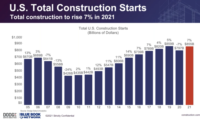Construction starts fell 27% in January compared to December, but the drop is not necessarily a sign of an ongoing slowdown, according to Dodge Construction Network’s chief economist, Richard Branch. January construction starts totaled a seasonally adjusted rate of $865.6 billion.
Dodge data also show that nonresidential building starts fell 38% from December, but compared to January 2022, nonresidential starts were only down 2%. Nonbuilding starts, which dropped 16% from December, were up 10% compared to a year earlier. Branch says the starts of “mega-projects” valued at $500 million or more over the last few months obscure the trend in construction activity.
“January’s decline in construction starts should not be taken as the beginning of a cyclical downturn in the industry,” Branch said.
For the 12 months ending in January, nonresidential building starts were 36% higher than the 12 months ending in January 2022, according to Dodge. Manufacturing starts, which dropped 91% from December to January, were still up 190% in the 12 months ending in January compared to a year earlier. A $1-billion Prime Data Center project in Elk Grove Village, Ill., was the largest nonresidential building start last month, followed by a $515-million Amazon data center in Hilliard, Ohio, and the $460-million CoStar Group campus in Richmond.
Nonbuilding starts were also higher in the 12 months ending in January than the same period ending in January 2022, by 18%, according to Dodge. The year-long gains were led by utility/gas plant starts and highway bridge starts. The $750-million High Banks wind farm project in Belleville, Kan., was the largest nonbuilding start of the month, followed by the $570-million first phase of a Highway 69 project in Overland Park, Kan., and a $492-million reservoir project in Palm Beach, Fla.
Unlike the other categories, residential construction starts were down in the 12-month period ending in January, by 5%. They also fell 20% from December.

Some economists have warned a recession could be possible as the Federal Reserve continues to raise interest rates. Branch says some sectors in construction will face stress this year, but overall “current fundamentals point to an industry that is fairly well positioned to weather the storm."





Post a comment to this article
Report Abusive Comment